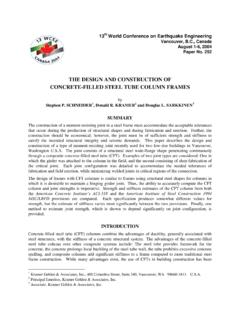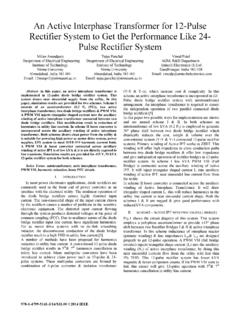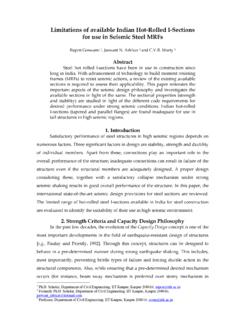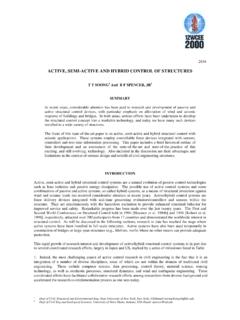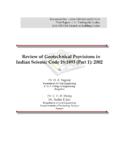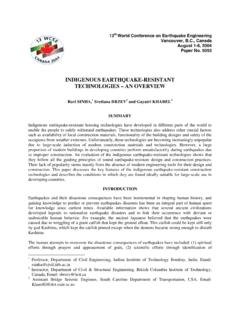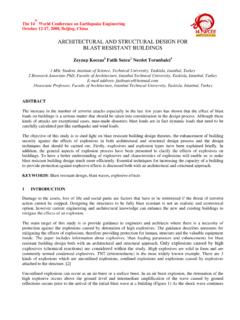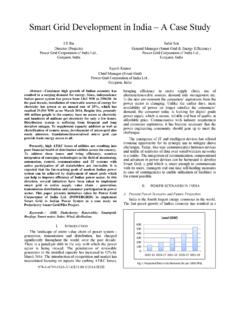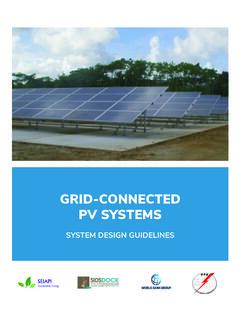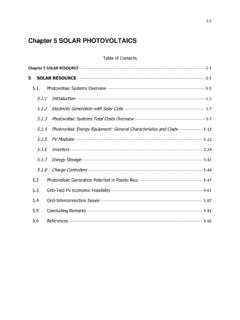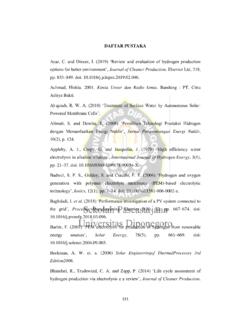Transcription of A Study on Grid Connected PV system - IIT Kanpur
1 978-1-4799-5141-3/14/$ 2016 IEEE A Study on grid Connected PV system J Sreedevi Joint Director Power system Division Central Power Research Institute Bengaluru, India. Ashwin N Senior Research Fellow Power Systems Division Central Power Research Institute Bengaluru, India. M Naini Raju Senior Research Fellow Power Systems Division Central Power Research Institute Bengaluru, India. Abstract photovoltaic (PV) energy has a fast growing annual rate and is quickly becoming an important part of the energy balance in most regions and power systems. This paper aims to Study the effects of connecting a PV system to the grid through simulation of the system in RSCSD software in real time on the Real Time Digital Simulator (RTDS).
2 Effect of variation of power factor of loads, variation of PV penetration, introduction of harmonics into the system by the PV inverter and anti-islanding effect of the PV system are studied. Finally, the Performance Ratio (PR) of a typical grid Connected PV system is evaluated to determine the reliability and grid connectivity of the PV system . Keywords grid Connected PV, Harmonics, Anti-islanding, Performance Ratio (PR), RSCAD, RTDS. I. INTRODUCTION An important source of renewable energy is solar energy. In India, the average annual solar energy incident on land area alone , is about 5000 trillion kilowatt-hours, because India gets about 300 clear sunny days in a year. The solar energy output received in a year exceeds the possible energy output of all the fossil fuel reserves in India.
3 From 10 MW of installed capacity in 2010 and MW in 2011, the installed grid Connected solar power capacity, as of 31st March 2016 in India is and an additional 10,000 MW by 2017 and total of 100,000 MW by 2022, is expected to be installed [1,2]. Some renewable energy projects are large scale, but renewable technologies are also suited to rural and remote areas in developing countries, where energy is crucial to human development grid Connected PV systems in the world account for about 99% of the installed capacity compared to stand alone systems, which use batteries. Battery-less grid Connected PV are cost effective and require less maintenance. Batteries are not needed for grid Connected PV, as the power generated is uploaded to the grid for direct transmission, distribution and consumption.
4 This eases the burden on other sources supplying power to the grid . In this paper, the impacts of connecting PV system to grid are studied. Further, the Performance Ratio of a typical grid Connected PV system in India is evaluated. II. IMPACTS OF CONNECTING PV system TO THE grid If the PV penetration is really high photovoltaic systems can subject the grid to several negative impacts. They are i) Reverse power flow, ii) Overvoltage along Distribution feeders, iii) Voltage control difficulty, iv) Phase unbalance, v) Power Quality problems, vi) Increased Reactive power and vii) Islanding detection difficulty. This paper considers the following three impacts. A. Power quality problems/Harmonics The inverter forms the core of the grid Connected PV system and is responsible for the quality of power injected into the grid .
5 Inverters also introduce harmonics into the system in the presence of non-linear loads, during DC to AC conversion. Harmonic currents introduce voltage drop and result in distortion of supply voltage. Harmonics can also cause resonance in the supply system , resulting in malfunction, reduction in lifetime or permanent damage of electrical equipment [3]. B. Increased Reactive Power photovoltaic inverters usually operate at unity power factor. The owners of small residential PV systems in an incentive based program are levied based on their kilowatt-hour yield and not on their kilovolt-ampere hour yield. Hence they prefer to operate PV inverters at unity power factor, maximizing the active power generation, and accordingly their returns.
6 As a result the reactive power demand met by the PV system is minimal. Hence, the grid is responsible for supplying majority of reactive power, and it makes the distribution transformer operate at a low power factor [3]. C. Islanding Detection The condition when the solar system continues to supply to the load even though grid power from the utility is not present is called islanding. Islanding can be dangerous to utility workers, who may not realize that a circuit is still energized while working on repairs or maintenance. Hence, the solar inverter must detect islanding and disconnect the PV system when the grid is down. This function of the PV system is known as anti-islanding [4]. These impacts are dependent on the size and location of the PV system .
7 According to the Solar America Board for Codes and Standards (Solar ABCs) PV systems are classified into three categories, based on the ratings of the system . Small-scale systems are rated at 10kW or less; Medium-scale systems are rated between 10kW and 500kW; and large-scale systems are rated above 500 kW. This paper considers large-scale PV system of 4MW for simulation III. system DESCRIPTION A typical grid - Connected PV system is considered for simulation, to Study the impacts of connecting PV to the grid . The single line diagram of the system simulated in RSCAD software for Study purpose is shown in The network consists of a PV array, which generates peak of 4MW in a day. A DC/DC converter , which is also used as a power optimizer, is equipped with control functions such as Maximum Power Point Tracking (MPPT).
8 The PV system is integrated to the grid by means of a DC/AC inverter, a step up transformer and an evacuating line of 33 kV. The point of common coupling is Bus1. The power is fed from PV system and the utility to the distribution network consisting of eight transformers. The PV array consists of modules. To arrive at a power output of 4 MW, the number of modules considered in series and parallel are 1500 and 30. The detailed data considered for PV array in simulation is given in Table I. Fig 1: SLD of Test system The data of 33 kV and 11kV cables is given in Table II. The distribution transformers data is given in Table III. The percentage impedance considered for all transformers is The loading conditions considered for the simulation is 80% of the transformer ratings.
9 TABLE I. PV MODULE DETAILS AT STC Cells per module 72 Number of modules in series (NS) 1500 Number of modules in parallel (NP) 30 Open Circuit Voltage (VOC) V Short circuit Current (ISC) A Maximum Power (Pmax) 235 W Voltage at Pmax V Current at Pmax A Ideality factor of PV diode Temperature dependency factor 3 Temperature co-efficient of ISC / 0C Reference Temperature (Tref) 250C Reference solar intensity (Insref) 1000 W/m2 TABLE II. 33KV AND 11kV CABLE DATA Parameters 33kV 11kV Name 3C x 25 mm2 3C x 25 mm2 R1 /km/ph /km/ph X1 /km/ph /km/ph B1 /km/ph /km/ph Where R1, X1, B1 positive sequence resistance, positive sequence reactance and positive sequence susceptance (B/2) respectively TABLE III.
10 TRANSFORMER DETAILS Transformer name Rating (MVA) Voltage rating (kV) TR1 3 4/33 TR2 5 33/11 TR3, TR4, TR5 33/11 TR6, TR7, TR8 11 IV. SIMULATION The system described in section III is simulated in RSCAD software of RTDS simulator. Steady state simulation of the system is checked for bus voltages and power flow convergence. The two impacts of grid connectivity discussed in section II are studied. BUSPV TR1 DC/AC inverter PV array DC/DC converter Utility (33 kV) TR2 TR3 BUS1 Load1 Load2 TR4 TR5 TR6 TR7 TR8 Load3 PI Section PI Section PI Section (a) A. Harmonics The amount of harmonics generated by the PV system depends on the type of solar inverter used.

